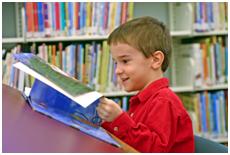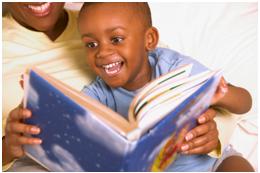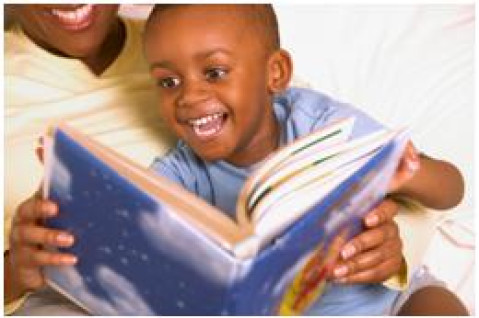Widgetized Section
Go to Admin » Appearance » Widgets » and move Gabfire Widget: Social into that MastheadOverlay zone
Where Theory Meets Practice: Researchers, Educators Agree With Lap Literacy
By Dana Rolison, Mae Daniel and Erica King
Imagine for a moment that you are five years old again. It’s your first day of school. Your main concern is making new friends, playing in the centers, and pleasing your very first teacher. At this age, magical things are occurring in your mind and the imagination extends way beyond that of an adult.
Now, imagine for a moment that you are a teacher of these incredible thinking creatures. You would need to understand that children at this age are not afraid to span their wings and take chances. In short, they are not afraid of failure. It is the job of the teacher to seek out new, innovative ways to teach and to convince others when a change is needed. As a teacher, one could only imagine how far great books, along with parental support, can expand the minds of these eager young learners.
 The authors of this article recognize the importance of reading to children at an early age and getting them engaged in sound reading practices. Exposing children to a variety of books and reading with them daily are important components of the literacy process. Although, many times the mothers appear to be most involved, research is beginning to capitalize on the importance of both parents. While fathers can contribute significantly to their child’s reading, they are also considered a fundamental factor in academic success in education in general. With that said, teachers need to find ways to welcome and educate both parents. Teachers indeed are the direct link in shifting new ideas and concepts, when compared to traditional methods.
The authors of this article recognize the importance of reading to children at an early age and getting them engaged in sound reading practices. Exposing children to a variety of books and reading with them daily are important components of the literacy process. Although, many times the mothers appear to be most involved, research is beginning to capitalize on the importance of both parents. While fathers can contribute significantly to their child’s reading, they are also considered a fundamental factor in academic success in education in general. With that said, teachers need to find ways to welcome and educate both parents. Teachers indeed are the direct link in shifting new ideas and concepts, when compared to traditional methods.
Lap Literacy
An effective means of empowering and encouraging parents to read with their children is for the teacher to engage in a “lap literacy” program. This entails the teacher sending home books daily to be read to the child and by the child. By providing quality-reading materials at the appropriate level, the teacher facilitates parental involvement that is meaningful for the student. Lap literacy has the benefits of reading aloud as well as many others. These benefits include teaching the child the value of reading, that reading is important enough to spend quiet, quality time on, and building a child’s self-esteem. A child with adults that do not see the value of reading aloud to them is deprived the opportunity to engage in a powerful tool for teaching reading. Along with the thrill of reading with an adult come the skills needed to read independently.
Getting Both Parents Involved
In 2009, The National Literacy Trust Research Summary identified the importance of involving both parents in the literacy process. This summary revealed that very little research was conducted on fathers, as the females appeared to capitalize parental involvement in reading in general. However, it was found that the father’s involvement in the reading process was more important than previously thought. In fact, the fathers’ reading habits were found to substantially influence their children’s reading ability, improve their appreciation and interest in reading, and partially determine levels of reading selections. In addition, the summary revealed that fathers were more apt to use higher-level vocabulary than the mothers were. With mothers being first, fathers were found to be the second most inspirational role model in terms of learning to read.
Extra Support for Students with Special Needs
Lap literacy affects the development of literacy skills with children who have special needs. The close, nurturing relationship felt between the child and parent enhances communication skills. Those students who have special communication needs tend to have problems with speech and language skills. Those critical literacy skills, reading and writing, are involved at the emergent literacy phase. During preschool, children are exposed to various literary elements in print form and in everyday situations. Parents should talk with their children often to prepare them for reading and writing exposure during the elementary years. Phonological awareness skills enhance when parents expose their children to rhyming and alliteration reading materials.
Over the last decade, there have been numerous studies evaluating emergent skill abilities in children with learning disabilities, including language, visual and hearing impairments, and those born prematurely due to crack cocaine. When exposed to the same literary techniques, these children experienced the same percentage of gains in literacy knowledge as normal developing children. According to a four-year study, crack cocaine children exposed to the same literary materials performed well in school and in some incidences excelled.
Literacy Activities
When babies begin to develop communication skills early in life, parents can expand learning opportunities with the use of intentional and non-intentional life events. Parents could become involved in this process by echoing their babies, naming items, or directing babies to objects of interest. Parents could also verbalize an activity while explaining steps to the baby while using environmental household objects. Parents could show books to their babies, talk about the pictures, and demonstrate turning pages in an appropriate manner. Later on, activities that involve listening, discussing, and telling stories using speech that is more elaborate would benefit the child.

There are several printed materials to assist with literacy development, such as, billboards and television advertisements, reading newspapers, spelling and defining words, logos, telephone directories, shopping signs, coloring and tracing letters, and utilizing the computer for writing and spelling activities. Language games and song singing on a daily routine provides children with opportunities to expand their repertoire of developing literacy skills. Nursery rhymes and playing “I Spy” card games enhance listening and speaking skills which aides to developing vocabulary, letter identification and knowledge, and phonological awareness. Parents should encourage children to read and write on an everyday basis and make them enjoyable events.
Conclusion
The best way to teach a child to read will probably continue to be a controversial issue among educators and researchers. However, one aspect seems to be agreed upon by all. The importance and benefits of reading aloud to children appears to be a common place about which both “teams” are resolved. Overwhelming support exists for the importance of educators and significant adults working together to improve the literacy skills of children. Through coordinated efforts, teachers and parents can learn from each other about the children’s literacy experiences, strengths, and areas of need. This cooperation can significantly and positively influence reading skills of children.
Teachers and parents need to consider new and innovative ways of getting children involved in reading. Parental involvement and sound reading practices are essential components in academic achievement. Children with high levels of literacy exposure and parental support were found to have a higher sense of self-worth and exhibited better behavior when compared to others. Sound reading practices and parental involvement subsequently leads to a desirable outcome in terms of academic success. It all begins with a child, an open mind to innovative reading strategies and parental support.
Dana Rolison, Ph.D. is an associate professor of education at the University of West Alabama. Dr. Rolison can be reached at [email protected].
Mae Daniel, Ph.D. is an assistant professor of online elementary education/early childhood and Erica King, Ph.D. is an assistant professor of online/special education. Both teach at the University of West Alabama. Dr. Daniel can be reached at [email protected]. Dr. King can be reached at [email protected].








 (1 votes, average: 4.00 out of 5)
(1 votes, average: 4.00 out of 5)
Pingback: Vanessa Smith
Pingback: Gregory Smith
Pingback: Dr Kali P Chaudhuri
Pingback: URL